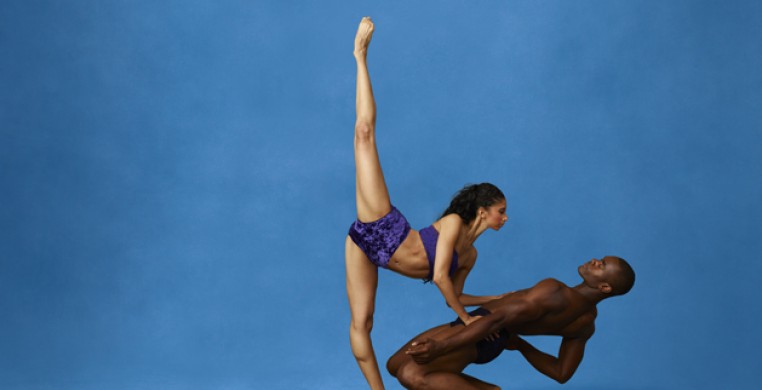Alvin Ailey American Dance Theater remains true to its mission of “celebrating the human spirit using the African-American cultural experience and American modern dance tradition” in its Chicago season opener this past Friday at the Auditorium Theatre and continuing with three rotating programs through March 9th.
It’s a credit to artistic director Robert Battle that less traditional choreography also continues to enrich the repertory of this world-class company with works like Wayne McGregor’s Chroma (2006), originally set on England’s Royal Ballet where McGregor is choreographer in residence.
In Chroma, Ailey dancers proved themselves more than equal to the technical and stylistic demands McGregor makes of his Royal Ballet troupe. Chroma is about light and space, dissonance and harmony, ripples and straight lines. A starkly-defined white rectangle suspended in the center of the back of the stage like a giant empty canvas in a vast art gallery grabs immediate attention. Bodies enter the canvas in silhouette and break the confines of its parameters, moving into a downstage field where every twitch is magnified and leggy extensions pierce the antiseptic blue of the stage with the sharpness of needles. The movement is geometric, modern art edgy, its abstract designs stabbing across a mutable surface of color. An opening duet sets the theme with sharp yet confined arm and leg thrusts and the flow of liquid torso and head undulations, the tension between the two contrasting energies mirroring the stridency of dissonant cello and piano. The music, by Jack White and Joby Talbot, surges into a driving percussion pulse for a mega-force men’s trio filled with the muscularity of bodies pulling, dragging, catching and falling in configurations both tender and forceful. Alicia Graf Mack stands out in a solo sequence with legs and feet like voracious animals that devour the space in go-for-broke extensions. The undulating theme echoes in a finale of blaring brass and full orchestra, the entire ensemble filling the empty canvas with an energy at once confined and screaming to go beyond itself.
Ronald K. Brown’s Four Corners changed the tone with African chanting, hand drums, and plenty of shoulder and pelvic isolations dominating earthy, African dance-inspired patterns. Here, body undulations take on an entirely different meaning--availability, lure, and ease. A joyous freedom unleashes the company in celebratory group leaping, spinning, hip-swiveling and stomping. Marshall Matthew Rushing wages a compelling dance with unseen demons, and Linda Celeste Sims lights up the stage with a burst of energy, then suddenly stops, extends her hand, and transitions into a group sequence with a more pop culture affect both in movement and music. Hardly a simple rendition of African dance, Brown merges exciting spatial trajectories and constantly-changing group configurations with a subtle blend of ballet (jetes entournant for instance) and modern dance falls that give the dancers ample opportunity to demonstrate technical virtuosity in a rousing canon that culminates with all eleven dancers rallying shoulder-pumping ecstasy.
Concluding the program, as it will every night, is Alvin Ailey’s best-known work, Revelations, as relevant and thoroughly entertaining today as it was in 1960. The difference is that in 1960, the Civil Rights Movement was just beginning to heat up, and Ailey’s use of African-American gospel and folk music from the South on the concert dance stage was revolutionary. Today, we categorize Revelations as traditional in its choreographic conventions and forms, but Ailey’s trail-blazing brilliance lay in his ability to use the modern dance vocabulary of Graham, Dunham, and Horton and transform it into something highly authentic, specific, and personal and yet transmissible to an audience that had never seen anything like it. This passionate and imaginative rendering of an era of black history through song and movement captured a universality of human experience that both transmitted and transcended ethnic roots and invited audiences of all races and nationalities to embrace its humanity. From the iconic group opening of “I Been ‘Buked” with the company in a pyramid formation of angel-like wings to the final rip-roaring “Rocka My Soul,” that is just what we do.

